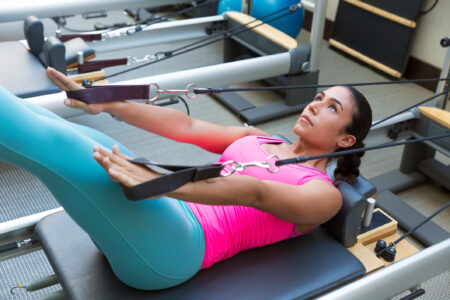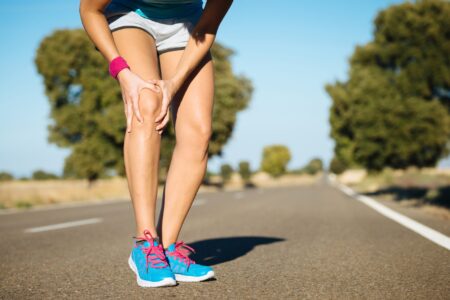Creating Good Habits
Late last year, myself and physiotherapist Luke Dowse had the pleasure of attending a presentation given by James Clear, author of the world-renowned book “Atomic Habits.” The presentation featured various personal growth and development philosophies discussed in the book, which as a whole centres around the formation of good habits.…
Read More >Tennis Elbow
What better time than the Australian Open to talk about one of the most common tennis injuries: Tennis elbow. What is Tennis Elbow? Tennis elbow refers to irritation of the elbow due to an overuse or overloading of the tendons in the outside part of the elbow (1). The bony…
Read More >Pilates: What is it? Would it help me? All you need to know.
What is Pilates? Pilates was originally developed in the early 1900’s by Joseph Pilates. Original exercise principles centered around mindfulness, body awareness, core and movement control, and breathing (1, 2). Over the years, physiotherapists and other health professionals have adopted and evolved these principles for use in the rehabilitation setting,…
Read More >GLA:D® Program for Knee and Hip Osteo-Arthritis
GLA:D® Australia is a not-for-profit initiative led by La Trobe University, and The GLA:D® Program is now coming to Continuum Physiotherapy! This article will tell you everything you need to know about the program, how to get involved, and if it is right for you! What is GLA:D®? GLA:D®, from…
Read More >Low Back Pain: The Unrelenting Chronic Lower Back (Part 3 Pain Series)
Chronic low back pain describes pain in the muscles, bones, joints, and/or tendons of the low back that has persisted for more than 3 months (1). It is the 9th highest cause of disability globally, and accounts for nearly 20% of General Practitioner visits in Australia (2, 3). Each person’s…
Read More >Managing Persistent Pain (Part 2)
In the first article in this series titled ‘Making Sense of Pain’, you can read about what exactly pain is, what it means for pain to be chronic, and how pain can persist in the absence of actual tissue damage or injury (here’s the link). In this article, you will…
Read More >Making Sense of Pain (Part 1)
What is pain? Pain is defined by the International Association for the Study of Pain as “an unpleasant sensory and emotional experience associated with, or resembling that associated with, actual or potential tissue damage.” (1) Importantly, pain itself is a personal experience. The actual process in our nervous system where…
Read More >Pain At The Side Of My Hip: What Is It? What Can Be Done?
This article will focus on pain located on the side of the hip, which is commonly referred to as ‘Gluteal Tendinopathy’ or ‘Greater Trochanteric Pain Syndrome (GTPS)’. What are the Signs of Lateral Hip Pain? Pain/tenderness over the greater trochanter or ‘bony part’ of the side of the hipPain when…
Read More >What is Causing My Shoulder and Arm Pain? Part 1: The Rotator Cuff.
Shoulder Pain has been shown to significantly affect people’s Quality of Life. A recent study found that of a group of 384 people; shoulder pain had the MOST impact on physical AND mental quality of life; when compared to low back pain, sciatica and knee pain (1). Shoulder pain is…
Read More >WORKSTATION SETUP: HOW TO REDUCE YOUR CHANCE OF NECK PAIN DEVELOPING
Key Points Related Workstation Setup: 1. Jobs requiring the use of a computer or video display terminal can result in awkward and sustained postures which has been demonstrated as causes of work-related neck and shoulder pain (1). 2. Various studies have shown that those working with a computer experience neck and shoulder pain,…
Read More >Severs Heel Pain – What Is It?
Severs, which is also known as calcaneal apophysitis (calcaneum is the heel bone), was first described by American Orthopaedic Surgeon James Warren Sever in 1912 and is considered inflammation of the growth plate in the heel of growing children (1). As children are growing, their bones are considered to not…
Read More >WHAT CAN I DO TO INCREASE THE SAFETY OF MY SPORT-PLAYING CHILD?
Sport participation has been shown to be a major cause of injury in adolescents. A lack of physical preparedness for the sport played has been shown to be one reason contributing to the risk of injury. Physical preparedness includes having adequate hip/knee/ankle muscular stability when landing from a marking contest or changing…
Read More >NECK-RELATED HEADACHES: HOW CAN I STOP THIS?
Key Points Related To Headaches: 70% of people with frequent intermittent headache report neck symptoms associated with their headache (1)Cervicogenic Headache is the name of the diagnosis where pain is felt in the head but being referred from a primary source in the cervical spine (neck) (2)PAIN IN THE FRONT OF THE…
Read More >“I’VE GOT TERRIBLE POSTURE”: HOW TO IMPROVE SHOULDER AND NECK PAIN
Key Points Related To Posture and Neck Pain Despite the overwhelming assumption in Australian society that posture is related to neck pain, research studies are conflicting suggesting it may not have as great a link as we thought.Some studies have found an association between forward head posture and pain, whereas other studies have…
Read More >WHAT’S THE MOST COMMON SOURCE OF NECK PAIN?
In the Global Burden of Disease study; 291 different conditions were assessed for their contribution towards disability encountered by people over a lifetime. Neck pain in Australasia was ranked 3rd highest (out of the 291) in the overall disability it affects people’s lives and ranked 4th in the world.80% of those with…
Read More >STRENGTHENING EXERCISES AND AGEING – WHAT’S THE BOTHER?
In Australia, 54% of women and 51% of men aged between 18 and 64 were considered physically inactive or insufficiently active. Physical inactivity increased to 65% in those aged 65 and above. Commonly, Australians are aware they need to perform “30 minutes of moderate physical activity per day”. However, many…
Read More >4 WAYS TO DECREASE YOUR PLANTAR FASCIA HEEL PAIN
1 out of 10 people experience Plantar Heel Pain (more commonly known as Plantar Fasciitis or Plantar Fasciopathy). 8% of running injuries are caused by Plantar Heel Pain (1,2). Those with Plantar Heel Pain typically experience: Pain that is worse in the morning (with the first few steps out of…
Read More >ANKLE SPRAINS – AM I AT RISK?
Lateral ankle sprains are a frequently occurring injury amongst the general population and sportspeople. 40% of all traumatic ankle injuries occur during sports (1). Lateral ankle sprains have the highest reinjury rate of all lower limb musculoskeletal injuries (2). Those who experience an acute lateral ankle sprain have a twofold increased re-injury…
Read More >PAIN AT THE FRONT OF MY KNEE – WHAT CAN I DO ABOUT IT? [PART 2]
atellofemoral joint pain syndrome (PFPS) is a common condition; where pain is felt around, behind or under the kneecap. For more about what this condition is; read our Part 1 article. Here is the link: https://continuumphysiotherapy.com.au/pain-at-the-front-of-my-knee-what-is-it-part-1/ The focus of this article is to provide tips on how to minimise your risk…
Read More >PAIN AT THE FRONT OF MY KNEE – WHAT IS IT? [PART 1]
Pain experienced at the front of the knee affects those who are physically active and inactive (1). A common source of pain felt at the front of the knee arises from the ‘patellofemoral joint’ – this is the joint where the kneecap bone (patella) and the bottom of the thigh bone…
Read More >DEADLIFTS AND SQUATS – ARE THEY BAD FOR MY BACK?
Low back pain is now the number one cause of disability around the world (1). Most adults will experience low back pain at some point in their life (2). In 2015, low back pain was the cause of 60.1 million disability-adjusted-life-years. One disability-adjusted-life year is considered one lost year of…
Read More >WHY THE NAME CONTINUUM PHYSIOTHERAPY?
The meaning of the word continuum has been described as “something that keeps on going, changing slowly over time”. That is very much like our physical bodies and particularly the lives we live. Health across the lifespan of an individual changes throughout various stages from infancy through to late adulthood…
Read More >




















